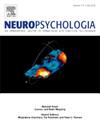Reduced mind-wandering and fewer depressive symptoms associated with damage to the medial prefrontal cortex and default mode network
IF 2
3区 心理学
Q3 BEHAVIORAL SCIENCES
引用次数: 0
Abstract
Depressive disorders have been consistently associated with elevated levels of mind-wandering and self-focused negative rumination. Separate tracks of research have implicated brain structures within the default mode network (DMN) in both mind-wandering and depression. In this study, we hypothesized that diminished mind-wandering and fewer depressive symptoms would co-occur in individuals with damage to the DMN. To test this hypothesis, we used a k-means clustering algorithm to identify a target group of patients with reduced mind-wandering and fewer depressive symptoms relative to brain-damaged comparison subjects (n = 37 of 68; ps < .001). The anatomical localization of lesions for this target group was predominantly within the medial prefrontal cortex (mPFC). Structural and functional lesion network mapping results revealed that lesions of the target group had significantly greater connectivity with DMN and limbic regions. Taken together, these results suggest that brain injury affecting the mPFC and DMN is associated with both reduced mind-wandering and fewer depressive symptoms. Further investigation of neuroanatomical substrates that mediate a causal relationship between mind-wandering and mood may facilitate the identification of new therapeutic targets for neuromodulation in patients with disorders characterized by maladaptive mind-wandering, such as rumination.
减少走神和减少抑郁症状与内侧前额叶皮层和默认模式网络的损伤有关
抑郁症一直与高水平的走神和以自我为中心的消极沉思有关。不同的研究表明,默认模式网络(DMN)内的大脑结构与走神和抑郁都有关系。在这项研究中,我们假设在DMN受损的个体中,减少走神和减少抑郁症状会同时发生。为了验证这一假设,我们使用k-means聚类算法来确定相对于脑损伤对照受试者而言,走神和抑郁症状减少的目标组患者(n = 37 / 68;ps & lt;措施)。该目标组病变的解剖定位主要在内侧前额叶皮层(mPFC)内。结构和功能病变网络映射结果显示,靶组病变与DMN和边缘区域的连通性显著增强。综上所述,这些结果表明,影响mPFC和DMN的脑损伤与减少走神和减少抑郁症状有关。对走神与情绪之间因果关系的神经解剖学基础的进一步研究,可能有助于识别以不适应走神为特征的疾病(如反刍)的神经调节的新治疗靶点。
本文章由计算机程序翻译,如有差异,请以英文原文为准。
求助全文
约1分钟内获得全文
求助全文
来源期刊

Neuropsychologia
医学-行为科学
CiteScore
5.10
自引率
3.80%
发文量
228
审稿时长
4 months
期刊介绍:
Neuropsychologia is an international interdisciplinary journal devoted to experimental and theoretical contributions that advance understanding of human cognition and behavior from a neuroscience perspective. The journal will consider for publication studies that link brain function with cognitive processes, including attention and awareness, action and motor control, executive functions and cognitive control, memory, language, and emotion and social cognition.
 求助内容:
求助内容: 应助结果提醒方式:
应助结果提醒方式:


